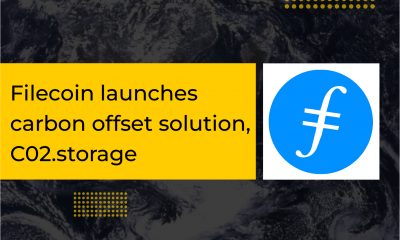FEATURED
What is Regenerative Finance (ReFi)?

With the advent of the blockchain, there have been several discoveries in areas where the quality of life can be improved significantly with blockchain technology.
One of which is Regenerative Finance, which helps combat climate change and also puts money in people’s pockets. This article will review Regenerative Finance (ReFi) and its use on the blockchain.
What is ReFi?
ReFi is a regenerative economic model that recognizes and rewards people for their contributions to society. Healthy earth is a byproduct of a flourishing community.
Imagine that you own land and that keeping the rainforest alive would bring you more money in the long run than cutting it down for timber, farming, or cattle grazing. Also, imagine that there was money to be made by looking for empty land and putting money into reforesting it.
This method leads to the creation of “good” land, which brings together the factors of production and gives you more money.
With ReFi, you can assign a monetary value to habitat restoration or biological variety by utilizing digital money, such as natural carbon-backed assets. Instead of habitat or biodiversity loss, this is the case. The greater the number of assets in circulation, the higher the value and incentives for more pristine habitats and biodiversity.
The model
ReFi is based on the theory of regenerative economics, which looks at how to make a system to restore and maintain the material resources needed for human well-being. It hopes to use financial incentives to get people to do things that are good for the ecosystem so natural resources can be renewed.
There are three steps to follow to make a model of economic regeneration effective. They are:-
- Assess the worth of preservation/regeneration,
- Turn it into a tradable asset
- Provide liquidity for that asset
These three steps are vital in making economic regeneration feasible.
ReFi and Web3
To ensure that other organizations can reap the benefits of Web3’s development without incurring any additional expenses, ReFi provides support.
After tokenizing natural assets for ReFi projects, users anywhere in the globe with access to the Web3 infrastructure, a wallet, and the DeFi application can invest in, buy, use, and trade tokens of these natural assets without needing to ask for permission. The ReFi project’s smart contract lets it unlock the tokenization, pooling, or standardization of natural assets, as well as the use of decentralized lending and AMM Swap. This makes the ReFi project better at using capital and making natural assets more transparent.
Take the Celo Project as an example. Celo has set in place, a system that makes it possible for people throughout the world who do not have bank accounts but do have cell phones to access financial services readily. There are currently over 1.7 billion individuals around the globe who do not have access to financial services – according to the 2021 Global Findex 2021 Report. This makes it more difficult for those types of people to achieve wealth. As a result, Celo remains dedicated to fulfilling its mission of making financial instruments accessible to everyone with a mobile phone.
At the moment, Celo is one of the more fruitful ReFi initiatives. Charles Eisenstein’s Regenerative Economics served as an inspiration for Celo. Its goal is to set up a monetary system and improve living conditions such that everyone benefits, including the earth.
One of the few projects to succeed in the ReFi space, Celo is a blockchain-based decentralized stablecoin and financial applications platform. Celo uses the L1 blockchain network, which operates inProof of Stake (PoS) mode and is compatible with EVM. Its novel aspect is that it can achieve some ReFi situations with the help of the phone identity system (PIS) and the Plumo ultra-light client technology.
PIS, which stands for Phone Identity System, is a service that uses validators to prove that new users can connect their wallet address with their phone number. This gives users the ability to send crypto assets to one another through their phone numbers. When seen from the user experience, something like this is more amenable to the growth of the user group.
Conclusion
Simply put, Regenerative Finance is a movement that uses web3 and the power of blockchain to fight climate change, protect the environment, and make the financial system more fair and long-lasting. Get involved today and help save the climate.
Read also:
What do you think of this article? Share your comments below.















1 Comment